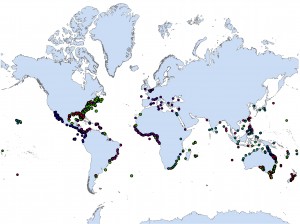This is a brief story about the origin of my thought to be a scientist creating maps for rare or “alien” creatures.
When I was a kid around ten, I was told hundreds of times that scientists are wise people who make difference and explore the unknown. I am always inspired by this word, and then it somehow has led me to be so eager to study rare creatures in the ocean that are poorly known by our humans.
But you might doubt how you could possibly study rare creatures if you cannot even find them? Where should you start? My answer is that you need to start from building a map. Suppose you just moved to Vancouver, and you need to find a shopping mall or sports centre. I’m sure you probably have to search that place on Google Map, which will show you clearly where it is. So this is also true for finding rare creatures. You definitely need a map to help you find and study organisms in the field.
As a young marine biologist, part of my mission is finding and conserving seahorses, a group of rare and threatened “alien” fishes. Seahorses are very tiny, cute, and charismatic animals, a genus shared by 48 species. To most of other common fishes (e.g. salmon), seahorses are totally “weird”. They don’t have apparent fins, scales, or streamlined profile. But the nature creates them with a horse-like head, an alligator-like body, and a monkey-like tail, just like a joint toy made by kids!!! What’s more? Male seahorses also have a unique part, a kangaroo-like pouch! And it is male seahorses that give birth!!! Every year, hundreds of millions of seahorses are captured mainly by trawling. Most of them are dried and traded in the market of Traditional Chinese Medicine, especially in Asia. Seahorse habitats are also being destroyed by fishing activities and other human pressures, e.g. pollution.
However, since seahorses have been rarely studied, we generally have little knowledge about them, especially their geographic distributions. Seahorses are “shy” and very good at hiding. They usually live in seagrass beds, macroalge, mangroves, and coral reefs. They can change their body color to mimic their habitats. This is part of the reason why they are rarely found under water and thus poorly known. Although, there are sighting records around the world to create a point map (see the figure), we don’t have an explicit map to show the exact boundaries of their habitats — we are sort of “shortsighted” or “half-blind”. This is just like Google Map showing the clear profile of buildings and blocks. Without this map, scientists cannot determine the ranges of waters where we can find them, which habitat areas should we protect, and thus no efficient conservation actions could be taken.
To conclude, I will create maps for seahorses around the world in order to guide their studies and conservation, making a big difference as I always dream to.
